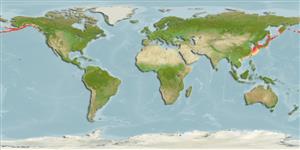Pycnogonida |
Pantopoda |
Ammotheidae
Environment: milieu / climate zone / depth range / distribution range
Ecology
Benthic. Subtropical
North Pacific: Alaska, Japan, Russian Federation and Bering sea (Ref. 2153). Subtropical to Boreal.
Length at first maturity / Size / Weight / Age
Maturity: Lm ? range ? - ? cm
Trunk circular in dorsal outline, lateral processes separated by tiny intervals, armed with paired low dorsodistal tubercles bearing setae. Ocular tubercle twice taller than its diameter, eyes prominent. Proboscis typical. Abdomen long, extending to distal tip of second coxae, fourth leg pair. Chelifore scapes moderately long, slender, equal to first and second palp segments in length. Palp second segment equal in length to fourth, otherwise typical. Oviger seventh segment with many lateral setae longer than segment diameter. Legs moderately long, armed with many tiny short ventral setae and fewer longer dorsal setae. Propodus fairly short, armed with 3 to 4 heel spines and 10- I2 shorter sole spines, auxiliary claws about 0.6 length of main claw (Ref. 2153, p. 3).
Shelf (Ref. 19).
Life cycle and mating behavior
Maturity | Reproduction | Spawning | Eggs | Fecundity | Larvae
Members of the class Pycnogonida are gonochoric and sexually dimorphic. During copulation, male usually suspends itself beneath the female. Fertilization occurs as the eggs leave the female's ovigers. Males brood the egg masses until they hatch. Life cycle: Eggs hatch into protonymphon larva then to adults.
Child, C.A. 1995 Pycnogonida of the Western Pacific Islands XI. Collections from the Aleutians and other Bering Sea islands, Alaska. Smithsonian Contributions to Zoology 569:1-33. (Ref. 2153)
IUCN Red List Status
(Ref. 130435: Version 2025-1)
CITES status (Ref. 108899)
Not Evaluated
Not Evaluated
Threat to humans
Human uses
| FishSource |
Tools
More information
Trophic EcologyFood items (preys)
Diet composition
Food consumption
Predators
Population dynamicsGrowth
Max. ages / sizes
Length-weight rel.
Length-length rel.
Length-frequencies
Mass conversion
Abundance
Life cycleReproductionMaturityFecunditySpawningEggsEgg developmentLarvae PhysiologyOxygen consumption
Human RelatedStamps, coins, misc.
Internet sources
Estimates based on models
Price category
Unknown.
